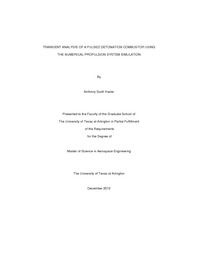
ATTENTION: The works hosted here are being migrated to a new repository that will consolidate resources, improve discoverability, and better show UTA's research impact on the global community. We will update authors as the migration progresses. Please see MavMatrix for more information.
Show simple item record
| dc.contributor.author | Hasler, Anthony Scott | en_US |
| dc.date.accessioned | 2013-03-20T19:12:30Z | |
| dc.date.available | 2013-03-20T19:12:30Z | |
| dc.date.issued | 2013-03-20 | |
| dc.date.submitted | January 2012 | en_US |
| dc.identifier.other | DISS-12062 | en_US |
| dc.identifier.uri | http://hdl.handle.net/10106/11608 | |
| dc.description.abstract | The performance of a hybrid mixed flow turbofan (with detonation tubes installed in the bypass duct) is investigated in this study and compared with a baseline model of a mixed flow turbofan with a standard combustion chamber as a duct burner. Previous studies have shown that pulsed detonation combustors have the potential to be more efficient than standard combustors, but they also present new challenges that must be overcome before they can be utilized. The Numerical Propulsion System Simulation (NPSS) will be used to perform the analysis with a pulsed detonation combustor model based on a numerical simulation done by Endo, Fujiwara, et. al. Three different cases will be run using both models representing a take-off situation, a subsonic cruise and a supersonic cruise situation. Since this study investigates a transient analysis, the pulse detonation combustor is run in a rig setup first and then its pressure and temperature are averaged for the cycle to obtain quasi-steady results. | en_US |
| dc.description.sponsorship | Wilson, Donald R. | en_US |
| dc.language.iso | en | en_US |
| dc.publisher | Aerospace Engineering | en_US |
| dc.title | Transient Analysis Of A Pulsed Detonation Combustor Using The Numerical Propulsion System Simulation | en_US |
| dc.type | M.S. | en_US |
| dc.contributor.committeeChair | Wilson, Donald R. | en_US |
| dc.degree.department | Aerospace Engineering | en_US |
| dc.degree.discipline | Aerospace Engineering | en_US |
| dc.degree.grantor | University of Texas at Arlington | en_US |
| dc.degree.level | masters | en_US |
| dc.degree.name | M.S. | en_US |
Files in this item
- Name:
- Hasler_uta_2502M_12062.pdf
- Size:
- 1.725Mb
- Format:
- PDF
This item appears in the following Collection(s)
Show simple item record


